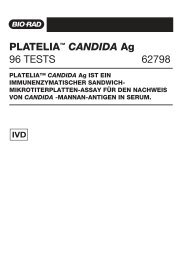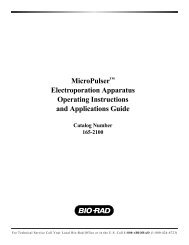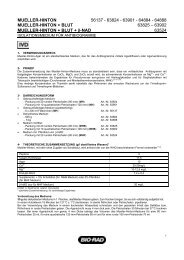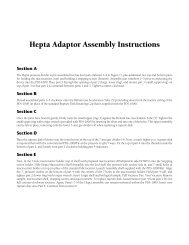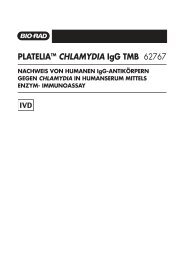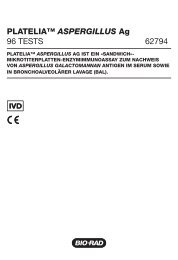Protein Expression and Purification Series - Bio-Rad
Protein Expression and Purification Series - Bio-Rad
Protein Expression and Purification Series - Bio-Rad
You also want an ePaper? Increase the reach of your titles
YUMPU automatically turns print PDFs into web optimized ePapers that Google loves.
APPENDIX G<br />
BIOMANUFACTURING<br />
<strong>Protein</strong> <strong>Expression</strong> <strong>and</strong> <strong>Purification</strong> <strong>Series</strong><br />
the proteins that they produce cost hundreds of millions of dollars to build. These plants manufacture<br />
pharmaceuticals under strict government regulations. Every procedure must be validated; that is, proven<br />
to be mistake-proof, <strong>and</strong> every piece of equipment must be proven to perform its function. All employees<br />
are specifically trained <strong>and</strong> must gown-up before entering manufacturing suites. The manufacturing plants<br />
are designed for easy cleaning, for a logical personnel flow, <strong>and</strong> for the airflow to be filtered ensuring it is<br />
free of any microbes that might contaminate the product. Each room is continually monitored to make sure<br />
that there is the lowest possible level of microbial contamination in the air, on the countertops, <strong>and</strong> on the<br />
floors. Every process follows a st<strong>and</strong>ard operating procedure (SOP), <strong>and</strong> personnel fill out paperwork called<br />
a production batch record in which they record every action. Periodically the government inspects the plant<br />
<strong>and</strong> checks these records to make sure that quality st<strong>and</strong>ards are strictly followed.<br />
Genetically engineered cells are grown under strictly controlled conditions in very large tanks called<br />
bioreactors. After the cells reach their maximum density in the bioreactor, they are separated from the<br />
growth medium, then lysed to release the protein that they have produced. Recovery techniques separate<br />
cellular proteins away from other cellular components, like DNA <strong>and</strong> membranes, <strong>and</strong> then the protein of<br />
interest is purified away from other cellular proteins. The Food <strong>and</strong> Drug Administration (FDA) requires that<br />
the final protein injected into a patient be 99.99% pure.<br />
Since the function of a protein depends upon its three-dimensional shape, all production, purification, <strong>and</strong><br />
delivery techniques must be designed to have the protein maintain this structure. Therefore, proteins are<br />
kept away from temperature extremes, pH extremes, organic chemicals, <strong>and</strong> extreme agitation that might<br />
denature (unfold) the protein <strong>and</strong> render it useless/ineffective. At each stage in the production process the<br />
protein must be surrounded by a solution of buffer molecules that moderate pH changes. It is also this<br />
consideration of preventing denaturation that dictates whether protein pharmaceuticals will be delivered<br />
directly into the bloodstream (parenteral) rather than delivered in a pill form. (If a protein were taken as a pill,<br />
the protein would denature the moment that it reached the acidic environment of the stomach.) Therefore,<br />
the final preparation of the protein must be placed in a solution that readies it for injection directly into the<br />
bloodstream.<br />
Upstream Process—The Growth of Genetically Engineered Cells<br />
The Research <strong>and</strong> Development team generates a large quantity of the genetically engineered cells <strong>and</strong><br />
freezes these cells in liquid nitrogen to form a master cell bank; this cell bank will provide the productproducing<br />
cells for the entire patent life of the product—20 years. A sample of cells is taken from the<br />
master cell bank <strong>and</strong> used to produce a working cell bank that will provide the cells for a production run,<br />
which is called a campaign). These cells are initially grown in a small flask containing a growth medium<br />
matching the requirements of the cell. Their cell division causes the culture to increase in concentration,<br />
but before the cells reach stationary phase (get too crowded <strong>and</strong> stop dividing), they will be transferred<br />
to a bioreactor <strong>and</strong> diluted with new media. This bioreactor will stir <strong>and</strong> aerate (add sterile air to) the cells<br />
to make sure that the culture remains aerobic at all times. The goals for the cells are to always generate<br />
their energy by cellular respiration <strong>and</strong> to prevent them from encountering anaerobic conditions that would<br />
cause them to supplement ATP production with fermentation. Probes inside the bioreactor monitor the<br />
temperature, pH, <strong>and</strong> dissolved oxygen concentration of the solution. If any of these parameters change,<br />
a controller initiates an action to push the altered parameter back to its set point. If the temperature of the<br />
medium goes up, cooling water removes heat as it floods through the jacket surrounding the bioreactor. If<br />
the pH becomes acid, then a pump turns on to inject base into the medium until the medium is neutralized.<br />
If the dissolved oxygen drops, the bioreactor increases the sparge rate of air being pumped in or can<br />
supplement the air supply with pure oxygen. This monitoring <strong>and</strong> reacting to changes maintains the cells in<br />
their optimum growth conditions <strong>and</strong> at their maximum cell division rates.<br />
As the cells divide they are systematically transferred to larger <strong>and</strong> larger volume bioreactors. The<br />
largest bioreactors in a major biotechnology company may be three stories tall. The gene coding for the<br />
recombinant protein of interest is always cloned behind an inducible promoter that allows the gene to be<br />
turned off for the entire growth phase of production. During this phase the cells devote their energy to<br />
230 Appendix G: <strong>Bio</strong>manufacturing




